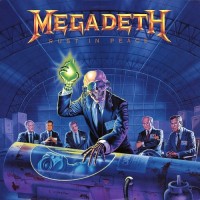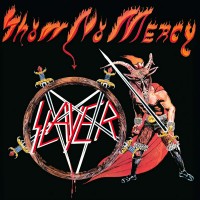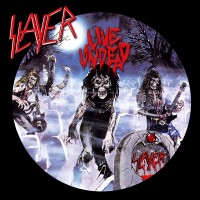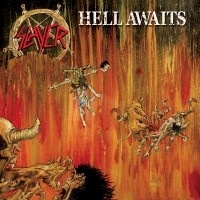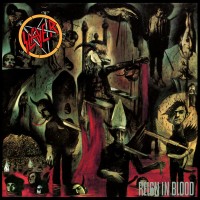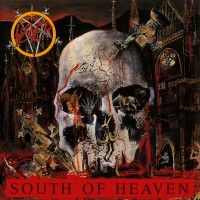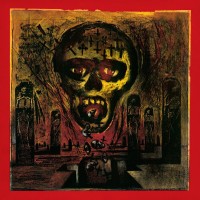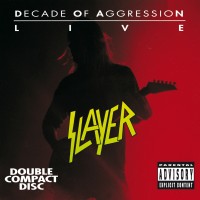Getting Into: Slayer: Part 1
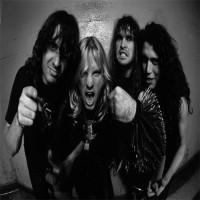
| Written by: | omne metallum |
| Published: | March 27, 2021 |
If you are a fan of heavy music, then listening to Slayer, excuse me, SLAAAAAAYEEEEERRR, is a rite of initiation for any would-be entrant to the club. Taking in and assessing the whole of the band's career will have you come to realize that the band produced more than their fair share of metal classics, from their '80's heyday as the heaviest and evilest band around through to the identity crisis that was the 1990's, before ending up finding their niche again and calling it a day in 2019.
This Getting Into series will be divided into two parts, each conveniently including live releases to highlight how Slayer was best experienced: live and in the flesh.
Grab your battle jackets and head to the pit: this is going to get heavy.
And so the journey begins.
Everyone has to begin somewhere, and for Slayer they began their careers as Venom imitators, though ones who traded in bombast and faux satanism for greater aggression and a focus on shaking your senses rather than scaring them. The band were still deeply rooted in their NWOBHM influences, with tracks like "The Antichrist" and "Tormentor" sounding like they were written as their version of a Blitzkrieg or Tank track.
This is not to say that there is nothing here but pale imitations; quite the opposite in fact, with tracks like "Evil Has No Boundaries", "Fight Till Death" and "The Final Command" showing that the band could produce strong tracks, if not the most original. "Die By The Sword" is only let down by Araya's voice being buried underneath effects that neuter any power he can bring to the track; given that power is his main weapon vocally, that's a hell of a handicap on him.
I wouldn't say that the album is particularly hindered by the band doing anything wrong, merely that they haven't perfected their winning formula yet; Araya hasn't found his vocal niche yet alongside Lombardo, who (flat drums aside) doesn't produce the kind of speed masterclass that he would later provide. King and Hanneman's playing is perhaps the real unique feature here, as they play simpler and more noticeable riffs/solos than the blurs of notes they would go on to become (in)famous for.
Worth working your way back to after starting with the classics, Show No Mercy may not sell you on Slayer by itself, but it will add a fair few more tracks to any playlist you may have of the band, plus it has good novelty value for looking at where the band started from.
Haunting The Chapel is perhaps the key point in Slayer's evolution, the exact moment the band pivoted from merely being a retread of their influences to producing a sound in their own right. The jump, not only in style but also production values, merely one year on from their debut is astounding; although the roots had taken hold, this is the first time it sprouts and the listener is able to reap the benefits.
"Chemical Warfare" is perhaps the go-to track when this EP is brought up in conversation; a precursor to Hell Awaits in style and sound, it is less a product of NWOBHM worship and more of the burgeoning thrash scene that was starting to take hold in the US, with Metallica's Kill 'Em All having been released a year prior. "Captor Of Sin" and the title track are no slouches either; their primal raging energy won't fail to get the blood flowing and ensure that this EP stands on its own merit rather than being proto-Hell Awaits material.
Given that this is merely a three-track release, take the score with a pinch of salt.
Live Undead is perhaps one of the more superfluous releases in the band's catalogue, as it was released when the band only had one album and an EP of material to cull from; given that said album was raw and stripped-down to begin with. then it's hard to see what a live release so soon after could offer fans.
When you press play, however, you will come to realize that Live Undead has a saving grace, in that it offers you a chance to hear some of the best tracks from Show No Mercy without the excessive reverb and effects, with guitars less restrained than they were in their prior versions. Tracks like "Die By The Sword" and "Show No Mercy" are perhaps even better than their studio versions, sounding less like the Venom-lite clones of the original versions and more in the shape of what Slayer was to become.
As mentioned prior, the shortcoming of this is the fact that it perhaps came too early in the band's career, meaning that Slayer had little in the way of material to play with; even with that in mind, however, they still managed to overlook tracks like "Chemical Warfare" and "Haunting the Chapel", which in hindsight was a big oversight. Live Undead is mainly worth listening to if you enjoyed Show No Mercy but were put off by its production.
Now this is where the legend really begins to take form; Hell Awaits marks the point where the band had learnt where their strengths and weaknesses lay and were able to craft a record that played to the former and cut out the latter. Now launching themselves off of the NWOBHM launchpad rather than standing atop it like they had on Show No Mercy, Slayer were now first and foremost a thrash band.
From the backwards masked voices that introduce you to the record to the ending fadeout of "Hardening Of The Arteries", you come to realize that there was no going back for either you or the band; you are hooked and wanting more of what Slayer have to offer. Heavy and unrelenting pummelling metal that dwells on the dark side of humanity and existence is the order of the day, and Hell Awaits dives right in from the off.
The album's strength lies in its mix of shorter and more straightforward tracks with longer and more complex (in comparison) songs that keep you on the edge of your seat and ensure you don't suffer from burnout. The use of mid-paced passages scattered throughout on "At Dawn They Sleep" gives the song an identity and breathing space without sacrificing heaviness, demonstrating that Slayer were not mere speed merchants.
Highlights would be the title track, "At Dawn They Sleep" and "Necrophiliac", three tracks that offer something similar but different to each other and highlight the progress the band had made up until this point.
Oh come on, how was this going to be anything less than 5? If you haven't heard "Angel Of Death" or "Raining Blood" then I'm sorry, please turn in your metal membership card now because you are doing it wrong.
This is the epoch-defining moment for the band, THE album; hell, some make a convincing case for this being the definitive thrash album of all time (one I don't attest to, but a strong case nonetheless), Reign In Blood is that strong of an album. Obviously, this is the place to start if you want to get into Slayer.
So what does Reign In Blood have to offer? Quite simply, its undiluted aggression that pushes things to the limit without sounding stale or contrite as it does so, managing to sit on the razor's edge while maintaining a catchy and unique character for each of its ten tracks ("Piece By Piece" and "Criminally Insane" may share the same slow drum intro but remain distinguishable from each other) and not falling into the abyss of becoming mere hyper-speed noise. It sits in that pocket just long enough that your adrenaline doesn't wear off and finishes before the comedown hits and you are able to catch your breath.
While this would be the start of the atonal guitar wailing that the band would eventually become meme'd for, it fits this record like a hand in a glove, adding to the sense of chaos and demonic nature of tracks like "Altar Of Sacrifice". The balance between strong riffage (I mean who hasn't at least tried their hand at playing "Raining Blood") and guitar chaos is again in that sweet spot while sat alongside Lombardo, who has finally been given the all-clear to just let rip, managing not only to keep up with the hyper-speed tempo of the material but supercharge it with his high-paced drum work ("Jesus Saves" being a prime example). Araya's voice has come of shape (or been beaten into form by this point) and narrates these tales of morbid reality in machine gun style while not tripping over himself (which is a feat on a track like "Reborn").
At 29 minutes long, just listen to the whole thing; though I know many will jump to "Angel Of Death" and "Raining Blood" first, just make sure you listen to the material in between, for it is just as strong.
Much like Metallica with ?And Justice For All/Metallica, how do you match a record with such a unique character and sound without either paling in comparison or running down a creative dead end? Simple, you don't even try, you switch things up to keep fans on their toes.
For my money, South Of Heaven is Slayer's best album and one that is somewhat overlooked in the band's discography, being seen as the weakest of the four-album run (spoiler alert) that set the bar for what the band could produce, starting with Hell Awaits and ending with Seasons In The Abyss.
Dropping the tempo from hyper-speed to merely fast or even mid-paced allowed the band to explore avenues that make for compelling listening, with "Mandatory Suicide" hooking you in with a simple guitar riff as you are regaled with a tale of conscription. Tracks like this would be ruined by an insistence on 'foot to the floor' levels of speed and choked before they could breathe. This isn't to say that the band dropped speed completely, rather that it is used in controlled bursts, making it that much more impactful when it does hit, being used to great effect on songs like "Cleanse The Soul" and "Behind The Crooked Cross", much like the thrash version of the grunge quiet/loud formula.
The band sound tighter and stronger for it, having a drier but more focused sound thanks to the work of Rubin, which allows you to hear clearly each and every note that went into the record. Lombardo's drums have a basic sound (audibly, not in terms of what he is playing), which injects the record with a level of power that elevates King and Hannemann further and sits alongside them in tracks like "Spill The Blood", making for a knockout of a track.
The strongest moments have to be the iconic title track, the aforementioned "Mandatory Suicide" and "Ghosts Of War", although there isn't a poor moment on the record, so don't be surprised if your choices don't match up with someone else's.
Almost like a compendium of what the band had produced to this point, Seasons In The Abyss combines the strengths of the last four albums and makes for a record that is the sum of its parts.
Tracks like "Born Of Fire" and "Hallowed Point" are made to the Reign In Blood formula, while "Blood Red" and "Seasons In The Abyss" are mid-paced affairs a la South Of Heaven, and "War Ensemble" and "Spirit In Black" are reminiscent of Hell Awaits and Show No Mercy, respectively. While these tracks are built to prior specs, don't think they are merely tipping their hats to better times; they are able to stand on their own merit and then some.
These mixes of styles may appear like a jumbled mess, but the band are able to weave them together into a coherent and flowing record that benefits the tracks massively. In large part this is possible due to Rubin's work behind the production desk, providing the band with a sound that is versatile enough to balance the energetic and unrelenting nature of "Born Of Fire" with the doom-esque/groovy nature of "Seasons In The Abyss", allowing the former to seep seamlessly into the latter without feeling disjointed or unnatural.
While everyone knows the title track and WAAAAAAAAAR Ensemble, there is plenty good to be found in the tracks that sit in-between, giving the album a strength in depth that atones to the quality of the record. Try your hand with the Ed Gein-inspired "Dead Skin Mask" or "Temptation" with its duelling vocals (a result of a happy accident) for some less immediate cuts.
Choosing a favourite track is like picking a winner in a crowded pack in a horse race; while you might fancy one, expect your mind to change repeatedly. Just pick anyone and you'll hit paydirt.
It is surprisingly rare that a band picks the right time to record a live album, either striking when the iron has gone cold by doing it after a few releases, meaning that the setlist is filled with obligatory new songs at the expense of deep cuts or rare tracks, or when the band are no longer at their peak? or the secret third option, where you release one after every album a la Iron Maiden.
Decade Of Aggression hits the sweet spot perfectly, coming at a time when the band had (unknowingly at the time) finished their run of classic albums, leaving the album chock full of the crème de la crème and when they were arguably at their peak as a live unit. As if to underscore just how successful their run had been, even the expanded edition means there are omissions of key tracks like "Necrophiliac" and "Piece By Piece", although the album does a good job of picking most of the key tracks from up to this period.
The album is undubbed, leaving you with a 'warts and all' experience, from Lombardo hanging on for dear life on "Born Of Fire" to Araya struggling not to trip over his words on "Jesus Saves". However, the album has been balanced in the mix, meaning that you fall short of a completely immersive experience, which is traded in for being able to hear everything throughout. The only drawback is that even with this mix, Araya's vocals are far too low and oftentimes he is a non-entity, sounding as if he is stuck in a box like on "Dead Skin Mask", which ironically is the least likely song to crowd him out on.
=========================
 | Written on 27.03.2021 by Just because I don't care doesn't mean I'm not listening. |
Comments page 2 / 2
- 1
- 2
- 1
- 2
Hits total: 3517 | This month: 68


